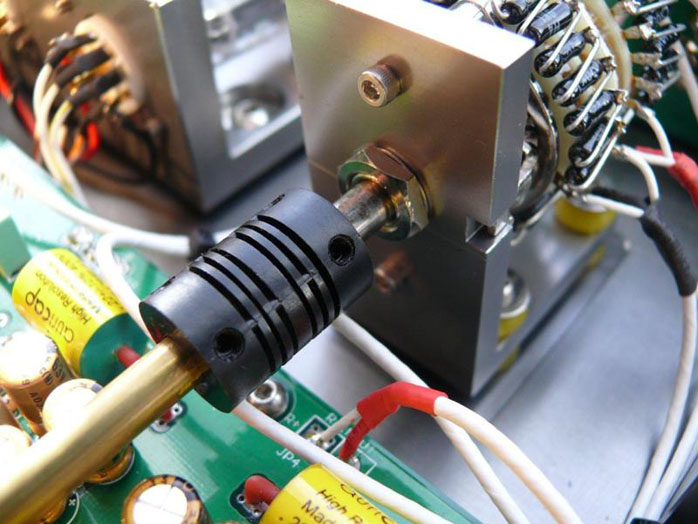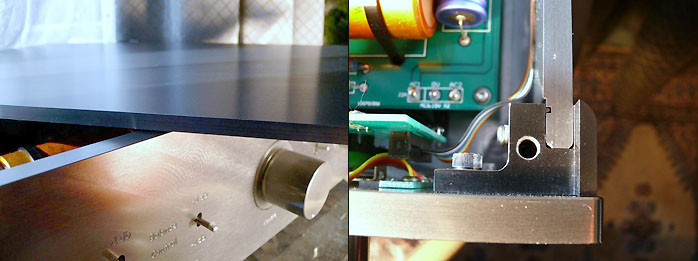This review page is supported in part by the sponsors whose ad banners are displayed below |
 |
 |
|
 |
Reviewer: Glen Wagenknecht
Financial Interests: click here
Source: Luxman Brid modified by Audio Upgrades to be a now tube-less, zero oversampling machine with integral volume control
Preamplifier: Audio Space Reference 2S
Amplifier:Bel Canto 200.4
Speakers: Apogee Duetta Signature, Paradigm Servo 15 subwoofer
Cables: Signal Cable Silver Reference interconnects and speaker cables, Audio Art SE cable loom
Resonance Control: Solid Tech, EquaRack Footers, Weizhi Precision Gold Glory footers, Boston Audio TuneBlock2 footers, Superspikes, and Black Diamond
Powerline conditioning: Noise Destroyer power filtration
Room size: 12' x 17'
Review Component Retail: $6500
|
 |
The design principle behind the Scorpio dual mono preamplifier is simple is elegant. But the term simple here is deceptive. The Scorpio is actually the result of a series of no compromise decisions and painstaking attention to detail, all calculated to offer a very high-quality product with a potentially higher level of accuracy. It’s certainly no 'simple' product but rather one with lofty ambitions which merit the preamplifier and the company to get a closer look.
Acousticbuoy is a Canadian-based firm located just outside Toronto, Ontario. It was founded in 2004 by CEO and chief design engineer Simon Man and his partners, design engineer Eric Lam and operational manager Freddy Tse. Although Canadian based, this firm in all aspects is a global player. Material purchases and consolidation span the United States, Europe and China. Component selection and basic parts manufacturing are performed in Hong Kong, final assembly and testing in Canada. Acousticbuoy presently offers two ambitious products. One is the 2488 DAC which already has received favorable press. The other is the Scorpio reviewed here. Aimed at a premium price point, it represents what the designers consider the absolute best they can achieve in purity of reproduction. Acousticbuoy advertises itself as a company "run by audiophiles for audiophiles." Have these audiophiles managed to build a better preamplifier?
|
|
|
Basic overview: On the surface this is a relatively Spartan line stage with only three inputs and no remote control. But each feature—or lack thereof—was carefully chosen towards one purpose - sound quality. The Scorpio is a full dual-mono tube design without negative feedback. Amplification is provided by one 12AU7 input tube and one 6C4 output buffer per channel, with a separate transformer per side. These transformers are isolated from the rest of the circuit by a thick plate to increase channel separation. The 6C4 promises better matching characteristics with most amplifiers. The specifications are remarkable, particularly the claimed .028% THD figure considering that this was achieved without NFB. This appears to be a very linear circuit.
|
 |
Strict attention to detail is found throughout. All chassis components are non-magnetic alloy steel and parts are hand-matched instrument grade. Resistors and capacitors use copper legs. The resistors are paralleled in pairs to create exactly matching values. Each input has separate channel relays connected in parallel. The precision stepped resistor attenuator is located at the back of the chassis to keep the signal path short and joined to the front volume knob by an instrument-grade universal joint.
|
 |
Care has been taken to eliminate various forms of interference and signal contamination. There are separate printed circuit boards for input selection, power supply, signal amplification and control. To minimize cross interference, the input board, amplification and buffer stage employ a 4-layer PCB where the 2nd and 3rd layer are for signal transfer, the 1st and 4th for ground and power. To reduce interference arising from common impedance ground paths, the Scorpio separates all low-level analog grounds from the digital signal grounds and terminates them at a single designated point on the system’s ground conductor.
|
 |
The case is described as a "full hermetically sealed aluminum chest". The chassis is comprised of 6mm thick aluminum slabs for the top, bottom and sides and 10mill for the front panel interlocking into thick corner assemblies. This elaborate rigid construction eliminates RF and minimizes vibration. The designer recognizes the pitfalls of microphonics and has taken further steps beyond case rigidity to address the problem. The tube bracket is a full 10mm thick and separated from the chassis via elastomer mat. The volume control bracket too is isolated with an elastomer pad.
|
|
|
Obviously the intent here was to eliminate everything which could contaminate the signal path and thereby allow the 12AU7 to operate at absolute potential. The tube is employed here not for euphonic effects but as a precision amplification device.
|
 |
 |
 |